Diabetes-related Retinopathy, Foot Ulcers, and Other Lesions: A Photo Essay
Diabetes-related complications include retinopathy, neuropathy, ulcerations.
Signs of early diabetic retinopathy are seen on this funduscopic image of a 63-year-old man who has had type 2 diabetes for 20 years. Examination identified hard exudates infranasal to the fovea, parafoveal microaneurysms, macular edema, and dot hemorrhages outside the retinal vessel arcades.
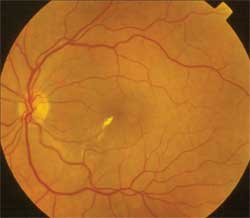
Image and case courtesy of Leonid Skorin, Jr, DO
Click here for the next image
Multiple, scattered intraretinal (dot-blot) hemorrhages and superficial nerve fiber layer (splinter) hemorrhages can be seen in this 56-year-old man with a 20-year history of type 2 diabetes and diabetic retinopathy. Numerous yellow, waxy, hard exudates are seen between the inner plexiform and inner nuclear layers of the

Image and case courtesy of Leonid Skorin, Jr, DO
Click here for the next image
Recurrent macular edema and pre-existing dot-blot and flame-shaped hemorrhages were noted in this patient previously treated with laser photocoagulation for nonproliferative diabetic retinopathy. Hard exudates composed of lipid and protein deposits are seen and a cotton-wool spot (nerve fiber layer infarct), also is visible.
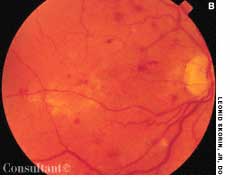
Image and case courtesy of Leonid Skorin, Jr, DO
Click here for the next image
Funduscopy found neovascularization of the optic disc, with blood in the vitreous directly over the macular area of the right eye in this 54-year-old woman with a 10-year history of insulin-dependent type 2 diabetes. A few hard exudates were seen (A). A large preretinal hemorrhage was detected in the infranasal quadrant of the left eye (B). Proliferative diabetic retinopathy was diagnosed.

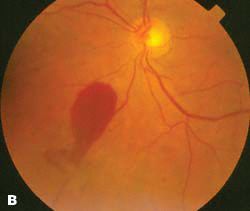
Images and case courtesy of Leonid Skorin, Jr, DO
Click here for the next image
A large sickle-like preretinal hemorrhage partially overlapping the optic disc and the surrounding retina is seen here in a 54-year-old woman with type 1 diabetes of 10 years’ duration. Pan-retinal laser photocoagulation was recommended for the patient’s proliferative diabetic retinopathy.
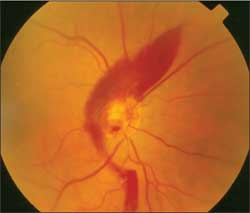
Image and case courtesy of Leonid Skorin, Jr, DO
Click here for the next image
In a patient with diabetes mellitus, a small, untreated blister can easily develop into a full-thickness foot ulceration. These complications, whether the result of infection, ischemia, neuropathy, or a combination of these factors, may quickly progress to sepsis or gangrene and lead to lower extremity amputations.

Image and case courtesy of Robert G. Frykberg, DPM, MPH and Donald Curtis, DPM
Click here for the next image
Diabetic foot ulcers may form in areas of sustained high pressure caused by structural deformities such as hammer toes or Charcot neuroarthropathy. Wound care entails debridement of necrotic, calloused, and fibrous tissue (as seen here); the application of topical enzymes and special dressings; and treatment of underlying infection and ischemia.
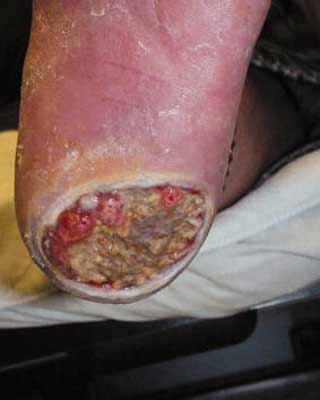
Image and case courtesy of Robert G. Frykberg, DPM, MPH and Donald Curtis, DPM
Click here for the next image
Biopsy of this gradually spreading plaque seen along the shin tibia of a 63-year-old woman found linear tiers of granulomatous inflammation, which consisted of multinucleated histiocytes aligned parallel to the epidermis. Necrobiosis lipoidica (NL) was diagnosed. NL may precede the onset of frank diabetes by an average of 2 years in 15% of patients.
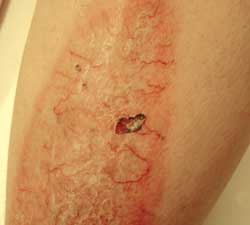
Image and case courtesy of Allison Cashman, MD
Click here for the next image
These lesions are characteristic of necrobiosis lipoidica and are composed of yellowish, firm plaques with large telangiectasia coursing over the top. About 70% to 80% of those with necrobiosis lipoidica have diabetes mellitus.
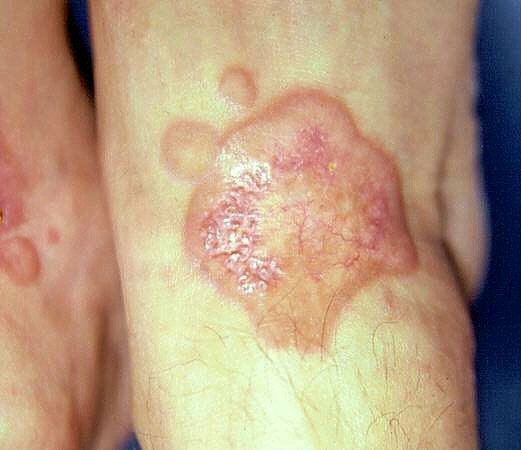
Image and case courtesy of Ted Rosen, MD
Click here for the next image
Known as perleche, the symptomatic red patches and plaques at the lateral labial commissures of the 66-year-old woman are most often due to localized overgrowth of Candida albicans. Perleche is also a known accompanying sign of diabetes. Patients typically complain of a burning sensation.
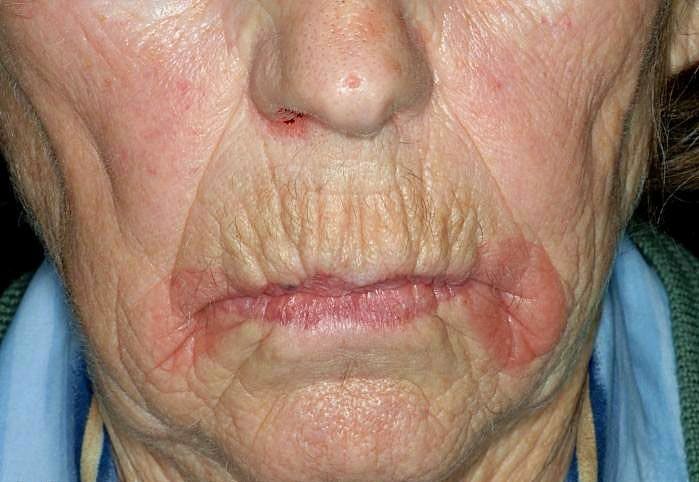
Click here to return to the first image.
2 Commerce Drive
Cranbury, NJ 08512
All rights reserved.